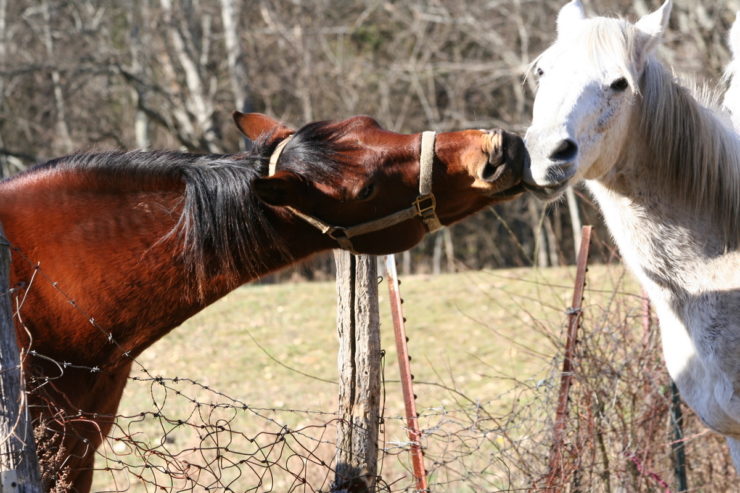We’re in the midst of Horse Birthday Season again here, that wonderful time of the year when, at apparently random intervals from a horse’s point of view, the equine population gets extra attention and Ceremonial Baby Carrots. We begin with the stallion at the end of February and end, in a rather nice feat of balance, with his younger sister in the middle of May. Everybody else bunches up in between, mostly in late April and early May.
This is a factor of horse breeding cycles. Horses can be born at any time of year, but optimal timing is in the spring, after the coldest weather has passed but before the summer heat. Here in Arizona, the window is narrower than it may be in cooler climates: We want the foals on the ground and their body thermostats well regulated before daytime temperatures hit the triple digits Fahrenheit.
In practice that means late March to early May. In more temperate climates, the range will shift: Foal birthdays will range from late April through July. Later than that and the last foals won’t be weaned before winter sets in hard—most breeders wean around six months, though some as early as three or four.
A number of breeds in the US have ruled that all foals of a particular year will have the same birthday: January 1st. This is the heart of northern winter, when most mares have shut down their heat cycles. They’ll ovulate every three weeks or so from along about March to along about October, but then take a break.
In the wild this makes excellent sense, since the large quantity of forage a mare requires to produce milk is minimal in winter, and the cold and the storms are a challenge for a young foal. In the human world, horse shows and races organize events by age. By making all horses born in a particular year the same official age, registries and rule books simplify their accounting enormously.
Buy the Book


A Hero Born
This means that a horse born in May or July or September or, god forbid, December, is officially a yearling on January 1st, though she may actually only be a few days or weeks old. As a result, breeders have to try to stack the deck. The earlier they can trick a mare into ovulating, the more advantage her foal will have in competition against other foals born in its birth year.
It’s not terribly complicated to convince a mare’s reproductive system that it’s spring. The trigger is light. If she’s kept in a stall under lights that mimic the longer days of spring and summer, she’ll begin to cycle accordingly.
Breeders will let their mares go into anestrus normally, then a month or two later will start putting them under lights, so that they’ll be ready for breeding in early February. This can get tricky for those trying for an early January foal—if it’s born prematurely, they end up with a week-old “yearling”—but for the most part it does work. With an average gestation period of 330-345 days (safe down to 320 on the low end and up past 400 on the high end), a mare bred in February has a pretty good chance of producing that coveted January foal.
Of course, mares being mares, none of this may work. She might not conceive on the first go, or she might conceive but then slip the foal. The breeder who really, really wants that cross may have to suck it up and take an April or May or June baby, and deal with the consequences once the young horse gets into competition. It’s a big problem for young-horse classes and futurities, and for racing two- and three-year-olds, but once the horse is mature, the age difference becomes much less of an issue.
As you may be able to tell from the opening paragraph, my breed, the Lipizzan, does not have a universal January birthday. We go by chronological age. That takes a great deal of stress off the breeding schedule, in that we’re not scrambling to get it all in as early in the year as possible. I’ve had a mare here from Minnesota with a July 21st birthday, and she’s not the latest I’ve seen. My February foal was the result of a test breeding of a young stallion—normally the farm would have waited, but they had the mare right there and the vial all ready to go, so what the hey, they said. And then he was born about ten days earlier than we expected based on his mother’s previous pattern. He was supposed to be a mid-March baby, from a farm that usually produced foals from April through June.
Hence all the April and May birthdays. That’s prime time for foaling in Arizona. February foal was born in a winter storm, which was its own saga. End-of-March foal arrived in lovely mild weather, and the April and May crops had at least a month to grow and thrive and adapt before the summer heat.
We’re no longer a breeding farm here, but we still know when spring is on the rise. In the world of the riding gelding, which will even eschew mares as “too emotional” for sensible riders or competitors, spring is the season when unclipped horses shed their heavy winter coats in fistfuls and clumps and clouds, blanketed horses either go naked or shift to their summer sheets or their fly sheets, and riders who clip their horses’ winter coats can get a break from the clippers. Then everybody gets ready for summer show season, and activity in the barn ramps up dramatically.
On the breeding farm, it’s a different world. We’re no longer firing up the foaling cams and checking the fences to be sure they’re baby-safe, upping the mares’ feed as they get ready to foal, then bracing for long nights of foal watch on the one hand, and monitoring the open or non-pregnant mares’ heat cycles and calculating when they’ll be bred on the other, but we know something’s happening. The stallion is notably more distractible and less placid than he tends to be in the winter. The mares suddenly stop ignoring him and start watching him closely, very closely, and making soft come-hither noises. Even the Great Old One, who will be thirty-two in May, starts sidling along the fence and casting sultry glances. Taking his favorite mare off the farm for a trail ride becomes an adventure, as he ramps and screams and flies up and down and winds up the whole rest of the place, while she screams back and prances and throws in the occasional capriole.
Our one gelding is used to it, but he doesn’t really see what all the fuss is about. Spring is when we remember why geldings are so outstandingly popular. As the saying goes, Geldings Are From Heaven.
Luckily for everyone’s nerves, spring passes in its due time. The mares’ cycles become less urgent. The stallion remembers where he left his other brain cell. The gelding sighs and rolls his eyes and carries on as he always does. It will all come back next year, he knows all too well. But in the meantime, he’s glad for the relative peace and quiet.
Top image by Daniel Johnson, licensed under the Creative Commons Attribution 2.0 Generic license, via WikiMedia Commons.
Judith Tarr is a lifelong horse person. She supports her habit by writing works of fantasy and science fiction as well as historical novels, many of which have been published as ebooks by Book View Cafe. She’s written a primer for writers who want to write about horses: Writing Horses: The Fine Art of Getting It Right. Her most recent novel, Dragons in the Earth, features a herd of magical horses, and her space opera, Forgotten Suns, features both terrestrial horses and an alien horselike species (and space whales!). She lives near Tucson, Arizona with a herd of Lipizzans, a clowder of cats, and a blue-eyed dog.










